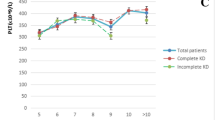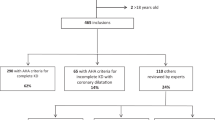Abstract
The aim of this study was to review the characteristics of patients with Kawasaki disease (KD) from Turkey and to assess the performance of the Kobayashi score (KS), Harada score (HS), Formosa score (FS), Egami score (ES) and other parameters in predicting intravenous immunoglobulin (IVIG) resistance and coronary artery involvement (CAI) in the Turkish population. Patients who were diagnosed as being in the acute phase of KD at Hacettepe University Faculty of Medicine (Ankara, Turkey) between June 2007 and January 2016 reviewed retrospectively, and those between January 2016 and February 2018 reviewed prospectively, were included in this cohort study. A total of 100 patients with KD were included in this study. Statistical Package for Social Sciences for Windows 22.0 (SPSS Inc, Chicago, IL, USA) was used for statistical analysis. Eighty-five patients (85%) responded to IVIG treatment, whereas 15 (5 female, 10 male) were IVIG resistant. CAI was detected in echocardiography at diagnosis in 31 (31%) (9 female; 22 male) patients. For predicting IVIG resistance, KS, ES, FS, and HS had sensitivity of 82.1%, 26.7%, 30.8%, 69.2% and specificity of 35.7%, 94%, 51.2%, 45.8%, respectively. For the association with CAI occurrence, the sensitivities were 17.2%, 3.3%, 35.7%, 70.4% and the specificities were 78.5%, 88.4%, 49.3%, 49.3% for the aforementioned scores, respectively. The multivariate analysis showed white blood cell (WBC) count [Odd’s ratio (OR) 4.1; 95% confidence interval (CI) 1.26–13.23; p = 0.019] and hematocrit (OR 3.8; 95% CI 1.15–12.4; p = 0.028), as independent predictors of CAI while gamma-glutamyl transferase (GGT) level (OR 5.7; 95% CI 1.73–27.51; p = 0.018) was detected as the only independent predictor of IVIG resistance. This is the first study from Turkey in KD to evaluate the association of the scoring systems for IVIG resistance and CAI. The risk scoring systems in KD did not predict the risk for IVIG resistance and were not associated with CAI in Turkish population.

Similar content being viewed by others
Abbreviations
- ALT:
-
Alanine aminotransferase
- AST:
-
Aspartate aminotransferase
- CAI:
-
Coronary artery involvement
- CRP:
-
C-reactive protein
- ES:
-
Egami score
- ESR:
-
Erythrocyte sedimentation rate
- FS:
-
Formosa score
- GGT:
-
Gamma-glutamyl transferase
- HS:
-
Harada score
- IL:
-
Interleukin
- IVIG:
-
Intravenous immunoglobulin
- IQR:
-
Interquartile range
- KD:
-
Kawasaki disease
- KS:
-
Kobayashi score
- MP:
-
Methylprednisolone
- OR:
-
Odd’s ratio
- ROC:
-
Receiver operating characteristic
- SPSS:
-
Statistical Package for Social Sciences
- WBC:
-
White blood cell
References
McCrindle BW, Rowley AH, Newburger JW, Burns JC, Bolger AF, Gewitz M et al (2017) Diagnosis, treatment, and long-term management of Kawasaki disease: a scientific statement for health professionals from the American Heart Association. Circulation 135(17):e927–e999. https://doi.org/10.1161/cir.0000000000000484
Batu ED, Ozen S (2012) Pediatric vasculitis. Curr Rheumatol Rep 14(2):121–129. https://doi.org/10.1007/s11926-011-0232-4
Eleftheriou D, Batu ED, Ozen S, Brogan PA (2015) Vasculitis in children. Nephrol Dial Transpl 30(Suppl 1):i94–i103. https://doi.org/10.1093/ndt/gfu393
Jennette JC, Falk RJ, Bacon PA, Basu N, Cid MC, Ferrario F et al (2013) 2012 revised international Chapel Hill consensus conference nomenclature of vasculitides. Arthritis Rheum 65(1):1–11. https://doi.org/10.1002/art.37715
Batu ED, Ozen S (2015) Vasculitis: do we know more to classify better? Pediatr Nephrol 30(9):1425–1432. https://doi.org/10.1007/s00467-014-3015-0
Burns JC, Franco A (2015) The immunomodulatory effects of intravenous immunoglobulin therapy in Kawasaki disease. Expert Rev Clin Immunol 11(7):819–825. https://doi.org/10.1586/1744666x.2015.1044980
Aoyagi R, Hamada H, Sato Y, Suzuki H, Onouchi Y, Ebata R et al (2015) Study protocol for a phase III multicentre, randomised, open-label, blinded-end point trial to evaluate the efficacy and safety of immunoglobulin plus cyclosporin A in patients with severe Kawasaki disease (KAICA Trial). BMJ Open 5(12):e009562. https://doi.org/10.1136/bmjopen-2015-009562
Marrani E, Burns JC, Cimaz R (2018) How should we classify Kawasaki disease? Front Immunol 9:2974. https://doi.org/10.3389/fimmu.2018.02974
Egami K, Muta H, Ishii M, Suda K, Sugahara Y, Iemura M et al (2006) Prediction of resistance to intravenous immunoglobulin treatment in patients with Kawasaki disease. J Pediatr 149(2):237–240. https://doi.org/10.1016/j.jpeds.2006.03.050
Kobayashi T, Inoue Y, Morikawa A (2008) Risk stratification and prediction of resistance to intravenous immunoglobulin in Kawasaki disease. Nihon Rinsho 66(2):332–337
Harada K (1991) Intravenous gamma-globulin treatment in Kawasaki disease. Acta Paediatr Jpn 33(6):805–810
Lin MT, Chang CH, Sun LC, Liu HM, Chang HW, Chen CA et al (2016) Risk factors and derived formosa score for intravenous immunoglobulin unresponsiveness in Taiwanese children with Kawasaki disease. J Formos Med Assoc 115(5):350–355. https://doi.org/10.1016/j.jfma.2015.03.012
Sleeper LA, Minich LL, McCrindle BM, Li JS, Mason W, Colan SD et al (2011) Evaluation of Kawasaki disease risk-scoring systems for intravenous immunoglobulin resistance. J Pediatr 158(5):831–835. https://doi.org/10.1016/j.jpeds.2010.10.031
Fabi M, Andreozzi L, Corinaldesi E, Bodnar T, Lami F, Cicero C et al (2019) Inability of Asian risk scoring systems to predict intravenous immunoglobulin resistance and coronary lesions in Kawasaki disease in an Italian cohort. Eur J Pediatr 178(3):315–322. https://doi.org/10.1007/s00431-018-3297-5
Loomba RS, Raskin A, Gudausky TM, Kirkpatrick E (2016) Role of the Egami Score in predicting intravenous immunoglobulin resistance in Kawasaki disease among different ethnicities. Am J Ther 23(6):e1293–e1299. https://doi.org/10.1097/mjt.0000000000000045
Song R, Yao W, Li X (2017) Efficacy of four scoring systems in predicting intravenous immunoglobulin resistance in children with Kawasaki Disease in a Children’s Hospital in Beijing, North China. J Pediatr 184:120–124. https://doi.org/10.1016/j.jpeds.2016.12.018
Shin J, Lee H, Eun L (2017) Verification of current risk scores for Kawasaki disease in Korean children. J Korean Med Sci 32(12):1991–1996. https://doi.org/10.3346/jkms.2017.32.12.1991
de Graeff N, Groot N, Ozen S, Eleftheriou D, Avcin T, Bader-Meunier B et al (2019) European consensus-based recommendations for the diagnosis and treatment of Kawasaki disease—the SHARE initiative. Rheumatology 58(4):672–682. https://doi.org/10.1093/rheumatology/key344
Ozen S, Sonmez HE, Demir S (2018) Pediatric forms of vasculitis. Best Pract Res Clin Rheumatol 32(1):137–147. https://doi.org/10.1016/j.berh.2018.09.007
Ozen S, Batu ED (2018) Vasculitis pathogenesis: can we talk about precision medicine? Front Immunol 9:1892. https://doi.org/10.3389/fimmu.2018.01892
Arane K, Mendelsohn K, Mimouni M, Mimouni F, Koren Y, Brik Simon D et al (2018) Japanese scoring systems to predict resistance to intravenous immunoglobulin in Kawasaki disease were unreliable for Caucasian Israeli children. Acta Paediatr 107(12):2179–2184. https://doi.org/10.1111/apa.14418
Wang Y, Li Z, Hu G, Hao S, Deng X, Huang M et al (2016) Unique molecular patterns uncovered in Kawasaki disease patients with elevated serum gamma glutamyl transferase levels: implications for intravenous immunoglobulin responsiveness. PLoS One 11(12):e0167434. https://doi.org/10.1371/journal.pone.0167434
Belay ED, Maddox RA, Holman RC, Curns AT, Ballah K, Schonberger LB (2006) Kawasaki syndrome and risk factors for coronary artery abnormalities: United States, 1994–2003. Pediatr Infect Dis J 25(3):245–249. https://doi.org/10.1097/01.inf.0000202068.30956.16
Sudo D, Monobe Y, Yashiro M, Sadakane A, Uehara R, Nakamura Y (2010) Case-control study of giant coronary aneurysms due to Kawasaki disease: the 19th nationwide survey. Pediatr Int 52(5):790–794. https://doi.org/10.1111/j.1442-200x.2010.03161.x
Rigante D, Andreozzi L, Fastiggi M, Bracci B, Natale MF, Esposito S (2016) Critical overview of the risk scoring systems to predict non-responsiveness to intravenous immunoglobulin in Kawasaki syndrome. Int J Mol Sci 17(3):278. https://doi.org/10.3390/ijms17030278
Clark DE, Denby KJ, Kaufman LM, Fill MA, Piya B, Krishnaswami S et al (2018) Predictors of intravenous immunoglobulin nonresponse and racial disparities in Kawasaki disease. Pediatr Infect Dis J37(12):1227–1234. https://doi.org/10.1097/inf.0000000000002019
Chantasiriwan N, Silvilairat S, Makonkawkeyoon K, Pongprot Y, Sittiwangkul R (2018) Predictors of intravenous immunoglobulin resistance and coronary artery aneurysm in patients with Kawasaki disease. Paediatr Int Child Health 38(3):209–212. https://doi.org/10.1080/20469047.2018.1471381
Jakob A, Whelan J, Kordecki M, Berner R, Stiller B, Arnold R et al (2016) Kawasaki disease in Germany: a prospective, population-based study adjusted for underreporting. Pediatr Infect Dis J 35(2):129–134. https://doi.org/10.1097/inf.0000000000000953
Kuo HC, Yang KD, Chang WC, Ger LP, Hsieh KS (2012) Kawasaki disease: an update on diagnosis and treatment. Pediatr Neonatol. 53(1):4–11. https://doi.org/10.1016/j.pedneo.2011.11.003
Sag E, Batu ED, Ozen S (2017) Childhood systemic vasculitis. Best Pract Res Clin Rheumatol 31(4):558–575. https://doi.org/10.1016/j.berh.2017.11.009
Huang SK, Lin MT, Chen HC, Huang SC, Wu MH (2013) Epidemiology of Kawasaki disease: prevalence from national database and future trends projection by system dynamics modeling. J Pediatr 163(1):126–131. https://doi.org/10.1016/j.jpeds.2012.12.011
Lin MT, Wu MH (2017) The global epidemiology of Kawasaki disease: review and future perspectives. Glob Cardiol Sci Pract 2017(3):201720
Funding
There is no funding source.
Author information
Authors and Affiliations
Contributions
Manuscript EAA; literature search EAA, EDB, SO; figure EAA, SO; study desing EAA, SO; data collection EAA, EDB, HES, SD, ZSA, ES, İE, DA, YB, SO; data analysis EAA, SO; data interpretation EAA, YB, SO; writing EAA, EDB, SO. All authors read and approved the final manuscript.
Corresponding author
Ethics declarations
Conflict of interest
The authors declare no conflict of interest.
Research involving human participants and/or animals
When the patients admitted to the hospital, the parents gave a general consent approving anonymous data use for academic purpose.
Informed consent
The written consents from the patient families were obtained according to the Declaration of Helsinki (1964) and the study was approved by the ethics committee of Hacettepe University (GO-16/45-15; approval date, 1st March 2016).
Ethics approval and consent to participate
The written consents from the patient families were obtained according to the Declaration of Helsinki (1964) and the study was approved by the ethics committee of Hacettepe University (GO-16/45-15; approval date, 1st March 2016).
Additional information
Publisher's Note
Springer Nature remains neutral with regard to jurisdictional claims in published maps and institutional affiliations.
Electronic supplementary material
Below is the link to the electronic supplementary material.
Rights and permissions
About this article
Cite this article
Arslanoglu Aydin, E., Ertugrul, I., Bilginer, Y. et al. The factors affecting the disease course in Kawasaki disease. Rheumatol Int 39, 1343–1349 (2019). https://doi.org/10.1007/s00296-019-04336-2
Received:
Accepted:
Published:
Issue Date:
DOI: https://doi.org/10.1007/s00296-019-04336-2




